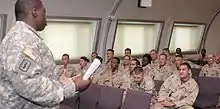Behavioral Science Consultation Team
The Behavioral Science Consultation Teams (BSCTs, pronounced "biscuits") are groups of psychiatrists, other medical doctors and psychologists who study detainees in American extrajudicial detention.[1]

History
The groups were being officially authorized by the US Department of Defense in mid-2002, following the advice of General Michael E. Dunlavey, later chief interrogator at Guantanamo Bay detention camp. The BSCTs proposed a three-step pattern for harsh interrogations, including sleep deprivation and psychological pressure:
Additional detention conditions they believed would further assist intelligence-gathering operations. These included using fans and generators to create white noise as a form of psychological pressure; restricting "resistant" detainees to no more than four hours of sleep a day; depriving them of "comfort items" such as sheets, blankets, mattresses, and washcloths; and controlling their access to the koran. "All aspects of the [detention] environment," they argued, "should enhance capture shock, dislocate expectations, foster dependence, and support exploitation to the fullest extent possible."[2]
The teams are controversial because some critics consider their participation in what is called enhanced interrogation of detainees in the war on terror a breach of medical ethics.[3]
When Darrel Vandeveld, one of the lawyers assigned to serve as one of military commission prosecutors looked into the case against Mohammed Jawad, one of the individuals he was assigned to prosecute, he realized that the record showed that Jawad, then still a minor, had been subjected to long periods of sleep deprivation, a torture technique that had already been de-authorized, on the advice of Army psychologist Lieutenant Colonel Diane M. Zierhoffer.[4][5]
Medical ethics
Such was the consternation of the American Psychological Association that in 2007 it adopted the resolution 'Reaffirmation of the American Psychological Association Position Against Torture and Other Cruel, Inhuman, or Degrading Treatment or Punishment and Its Application to Individuals Defined in the United States Code as "Enemy Combatants"' to make clear that any torture and other cruel, Inhuman, or degrading treatment was unethical, whatever the situation.[6]
References
- Shanita Simmons (January 4, 2008). "Hard work of BSCT validated by peers" (PDF). The Wire (JTF-GTMO). p. 4. Archived from the original (PDF) on February 27, 2012. Retrieved 2008-02-10. mirror
- Ethics Abandoned: Medical Professionalism and Detainee Abuse in the War on Terror. Institute on Medicine as a Profession (IMAP) and Open Society Foundations (OSF). Columbia University, 2013, p. 29.
- Katherine Eban (July 17, 2007). "The War on Terror: Rorschach and Awe". Vanity Fair magazine. Retrieved 2008-03-02.
-
Jeffrey Kaye (2011-04-19). "Guantanamo Psychologist Led Rendition and Imprisonment of Afghan Boys, Complaint Charges". Truthout. Retrieved 2016-10-11.
Zierhoffer (who was identified separately in an article [16] at Daily Kos), working with interrogators, "encouraged them to continue to dial up the emotional pressure on Jawad: 'He appears to be rather frightened and it looks as if he could break easily if he were isolated from his support network and made to rely solely on the interrogator,' according to an excerpt of the report read to Newsweek.
-
"GITMO: Psychologists and torture". Newsweek magazine. 2008-10-17. Retrieved 2016-10-11.
Since 2002 psychologists have observed interrogations and suggested specific ways to exploit the weaknesses of detainees, including Mohammed Jawad, whose disturbing case is now being heard by a military tribunal in Guantánamo.
- "Reaffirmation of the American Psychological Association Position Against Torture and Other Cruel, Inhuman, or Degrading Treatment or Punishment and Its Application to Individuals Defined in the United States Code as "Enemy Combatants"". American Psychological Association. August 19, 2007. Retrieved 2008-03-02.